Are Google ads worth it in 2022? An Ambitious (yet simple) guide
[Updated June 2022]
One word. Yes. Google Ads are definitely worth it.
Quick Links
Want to know why? Let’s discuss this in detail.
Google Adwords is Google’s online advertising program. With Google Ads, you can create online ads to reach people looking for your products or services. You decide where your ad appears, set a budget that’s comfortable for you, and measure the effectiveness of your campaign.
Google Ads is a powerful platform, especially for small businesses. If you know the cost and margin of your product then Google Ads is a no-brainer.
Businesses often see 3-10X the return on their investment, but many business owners are still scared to dive in.
You can check Better Metrics for more insights on your Google Ads data.
Why?
Well because it can be challenging to set up a Google Ads campaign.
Google introduced Google Adwords (now Google Ads) 20 years ago in 2000. Yet, the essence of Google Ads has not changed in the last two decades.
Google has become a staple of the marketing community. You can see how Google’s ad revenue has increased since 2001 in the following chart by Statista:
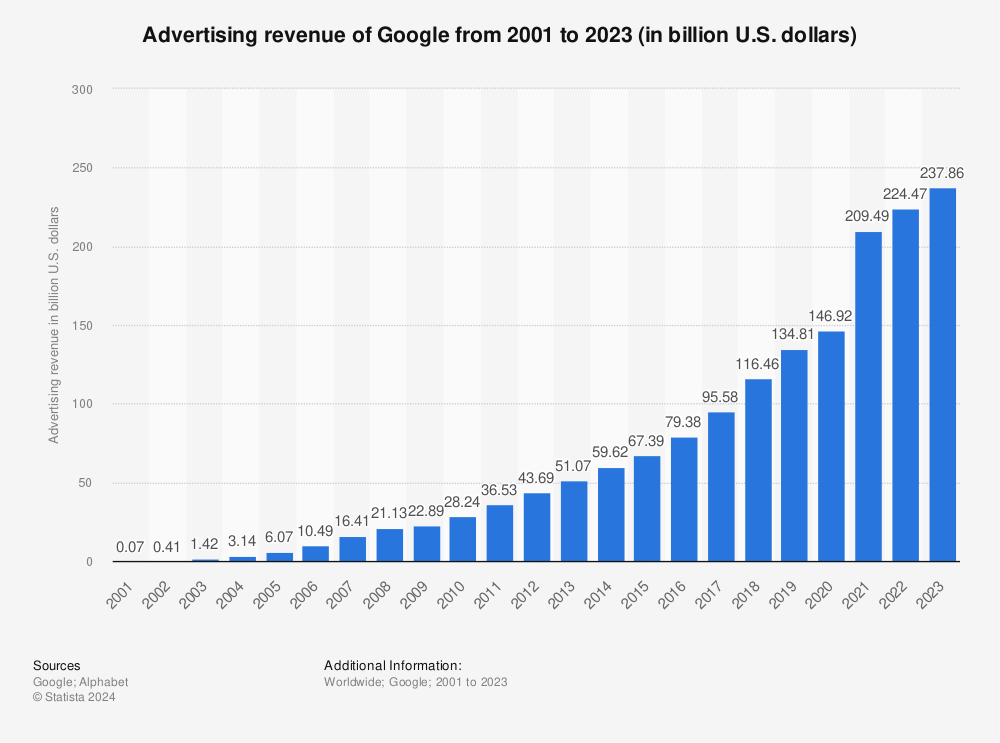
Find more statistics at Statista
For any business, no matter how big or small, using Google for advertising will bring insane benefits.
Google Ads allows you to:
- Take advantage of Google’s immense reach. According to Smart Insights, Google’s number of daily searches exceeds 3.5 billion.
- Limit your daily budget and maximum bids to make sure that you’re not spending more than you’re supposed to.
- Reach the right customers at the right time. When you are looking for “plumber (insert city)” you know that person is ready to buy.
- Get faster results than search engine optimization. You can use a dashboard to track progress against your KPIs, such as your conversion rate, to help you visualize your marketing strategy’s performance.
Although many websites still rely on search engine optimization, it often can be months before your results are indexed by Google. We still recommend SEO, but with Google Ads you can get organic traffic faster, no wait needed.
When you generate organic traffic quicker, the benefits to your business come in a domino effect. You can expect more prospects and higher conversions. It means that Google Ads can accelerate your sales faster. Moreover, you can reach out to more people and engage with potential customers faster, giving you an edge over your slow competitors.
To Create your Google Adwords Campaign, you also need Google Ads Credits. Here In this Web Me Tools’s Google Ads Coupon & Credit article, 6 ways are shared to get free credit up to $200 that you can use on Google Ads Campaign.
This article offers a practical, foolproof guide, to your first campaign on Google Ads. If you’re reluctant to use Google Ads because it’s your first time, by the end you will be able to test the waters and be more confident about your next Google Ads campaigns.
How Does Google Ads Work?
Google AdWords is a marketplace where companies bid on keywords to have their website show at the top of the search.

In this example, Grubhub was able to outbid Dominos to claim the top spot for the keyword “pizza delivery.”
However, the highest bid doesn’t always win. Google incentivizes companies to ensure that the user experience remains high. Google will combine the a quality score (how the website relates to the keyword) along with the bid amount.
The person with the highest quality score and bid amount wins.
Step #1: Set up Google Ads Account
Setting a Google Ads campaign is really just about following some directions. First of all, to set your account you need to visit Google Ads Home page and click on the ‘START NOW’ button.
After you click start now you will see a page where you can put in your website, but I recommend to leave and navigate to the adwords dashboard. We want to manage the campaigns from because you have more flexibility and control of the campaign.
Step #2: Start a Google Ads Campaign
After you created your account and navigated to the main dashboard. In the left-hand column, you will want to click on campaigns.
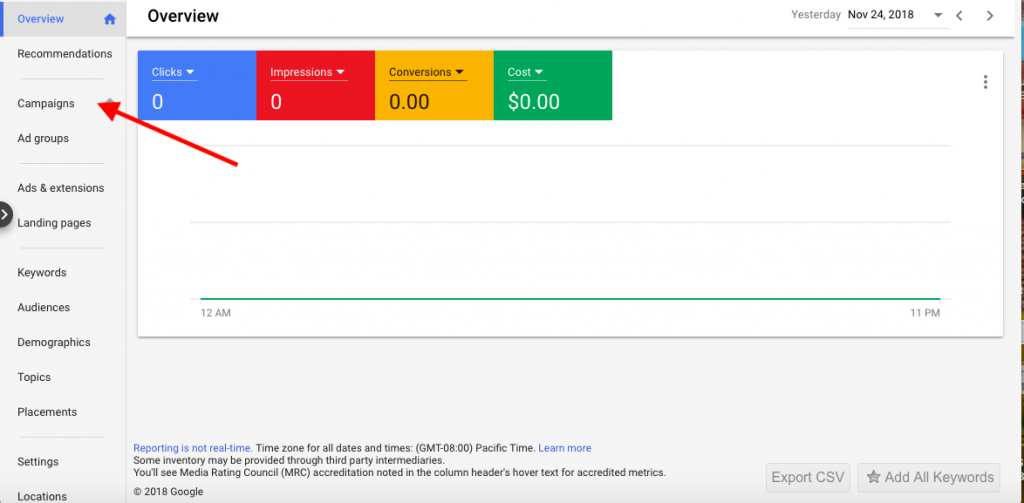
After you will see a blue button with a “+”. Click the blue button and click “New campaign”.

On the next page, the first thing you see is an array of options for the “goal” that you want to achieve.
For 99% of businesses, their main goal will be to convert website traffic into leads. The main purpose of this area is to allow us and Google to track when an event happened so you can better track your ROI.
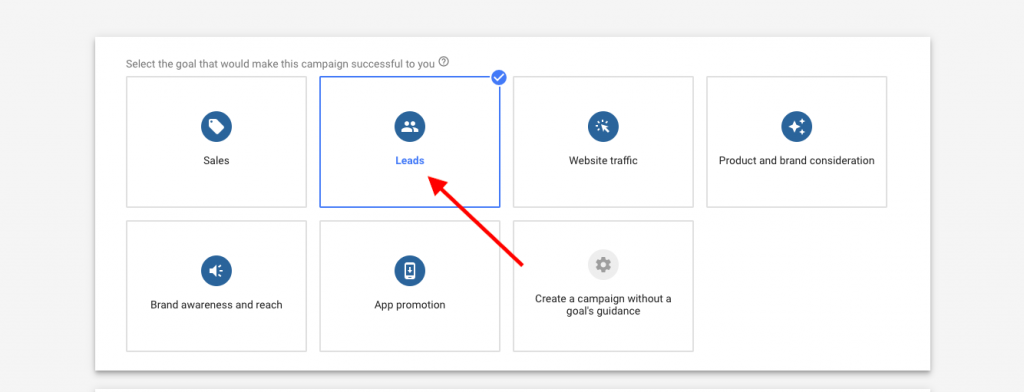
Beneath this section, you will see different campaign types.
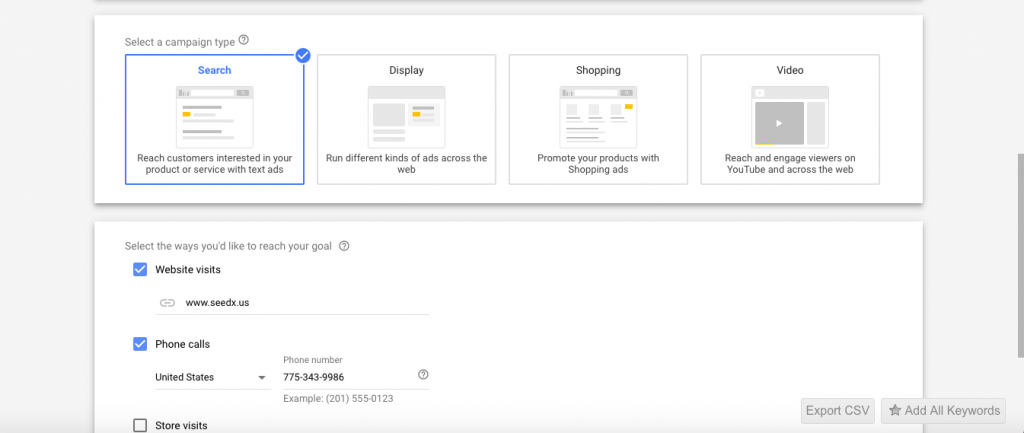
In this guide, we will mainly be going over Search campaigns as this is where we will best be able to track buyers intent for specific services.
Display campaigns are used to help spread awareness of your brand. This is great if you want more people to know about you. You often see display ads on blogs and other websites in sidebars. For our campaigns, it is not needed.
The shopping campaign is a new type of campaign for e-commerce businesses. We will not be able to cover it in this guide, but please message us if you have questions specifically tailored to e-commerce.
Use video ads to bring your story to life. Utilize YouTube to reach potential customers as they watch or search for videos – and only charge them if they are interested.
You can increase your brand’s visibility by capturing attention and driving demand at scale with video ads.
Find the users who will enjoy your app. App Campaigns allow you to advertise your iOS or Android app on Google Search, YouTube, Google Play, etc. We will optimize your App ads to reach the most interested audience in apps like yours using our technology.
After you select “Search” campaign you will be asked click how you will track your conversions. We will put in both traffic and phone calls as we want people either coming to our website and submitting forms or calling us directly.
Click “Continue” and you will be directed to a new page.
Step #3: Define Campaign Audience
We are still creating a campaign, but on this next section, we will get more into the audience of the campaign.
On the first part, name your campaign as well as make sure that you unselect network audience.
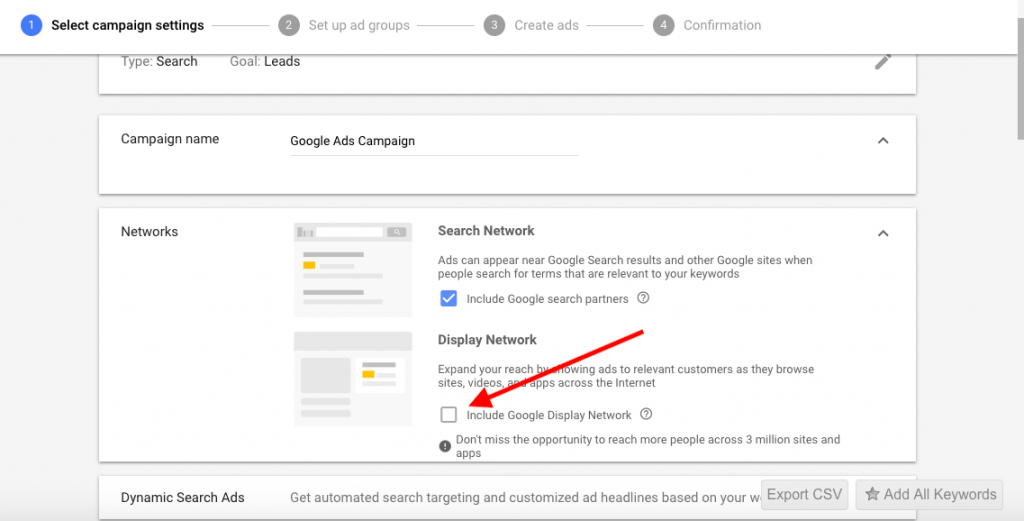
After this section, you will pick the location that you will want to target.
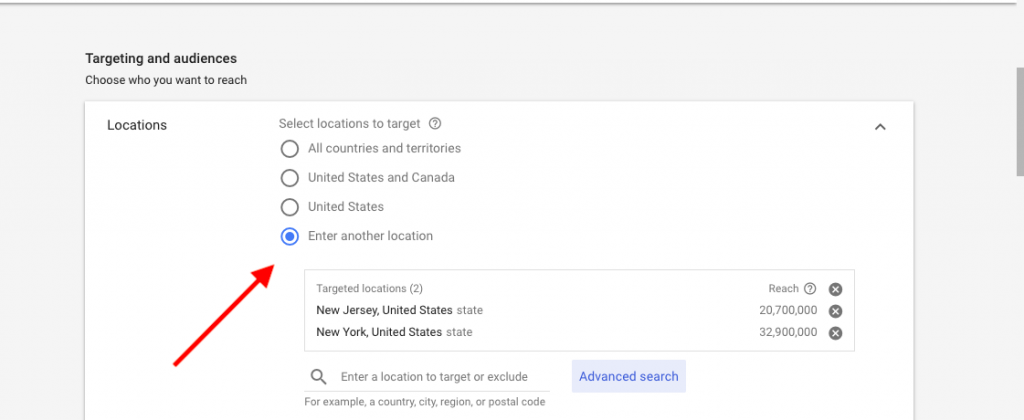
In this section, you will want to manually put in the location that you want to target. If you are from Morris, Pennsylvania you can target your exact city.
If you click on “Advanced search” you can also target your location by radius.
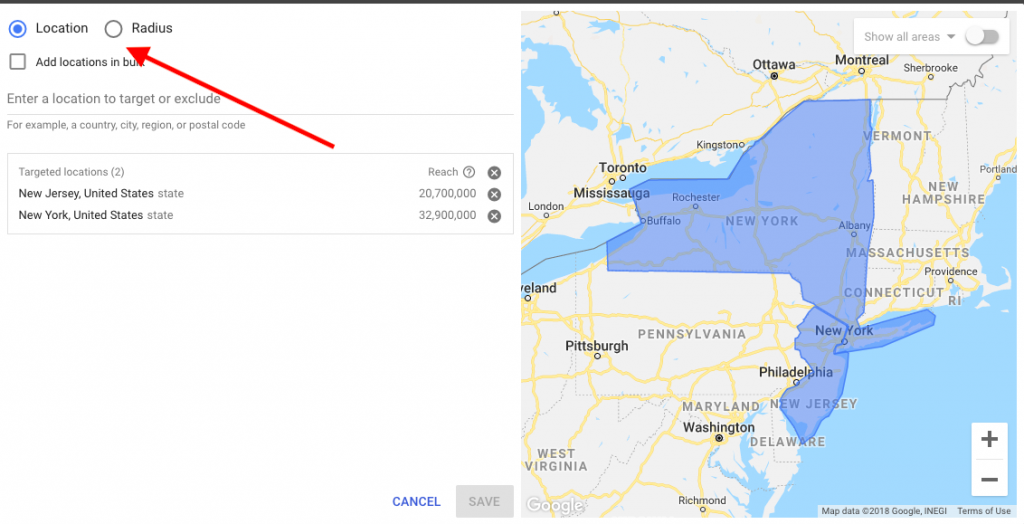 Now you will also want to go to “Location options” and select the best options for you.
Now you will also want to go to “Location options” and select the best options for you.
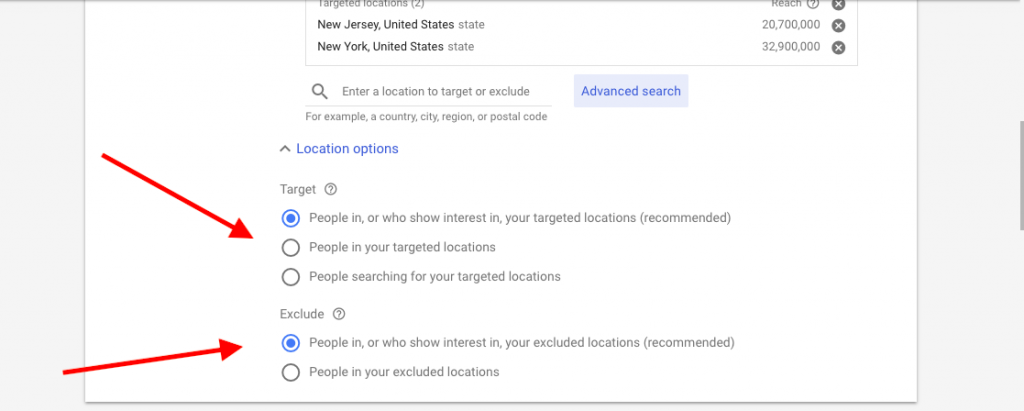
Not all people might be searching for your keyword in your target area. This can be both a good thing and a bad thing. For example, if you are looking to rent your apartment to vacationers then you might want to target people who are outside of your target location, but searching for your service. However, some people might be searching “plumber reno, nv” and might be located outside of Reno. This person could be searching for someone else, could be searching pricing of different areas, etc. Depending on the campaign you might want to also target these people.
In the next section, you will target all people in your desired language. For audiences, we will ignore that section. If you are curious you can read about Google Ad audiences.
Step #4: Choosing Your Google Ads Budget
This section often confused people but is a lot easier than you think. With some simple math, you can figure out how much you should be spending on Google Ads.
In order to know how much you should spend you need to know your profit per sale and your conversion rate.
If you are a hair salon and your service costs $100 and out of that $100, you make $50 profit then $50 will be your profit per sale.
Your conversions rate is the number of leads or purchases that occur per visit to your website. If a 1000 people visit your website and 10 people contact you, then that is a 1% conversion rate.
Would you be willing to make $20 dollars per customer instead of $50? That means you would be able to pay $300 dollars (3X10) to gain 10 new customers. So for 1000 clicks at a 1% conversion, you could pay $0.30 per click.
If you can spend $75 dollars a week ($300 dollars a month) you should acquire 10 new customers a month. Your daily ad budget would be $10 dollars roughly a day.

Now that we calculated our daily budget input it on the page as well as the delivery method. We normally choose standard for the delivery method. The difference between standard and accelerated is in the standard delivery they will optimize your budget over a week, but in the accelerated, they might spend it all on one day.
Step #5: Defining Your Google Ads Bidding Strategy
The next section is the area where you put your bidding strategy.

There are several strategies that you can utilize to help maximize your budget, but for now, we will start with a manual cost per acquisition.
In the advanced strategies, you can set it so that Google will automatically raise or lower bid amounts in order to get the best conversion rates at any one time.
For our example, we’ll set the target cost per action as $30 dollars. As you progress your ad campaign you can begin to lower this number to get the most out of your ad budget.
Step #6: Google Ad Extensions (DO NOT FORGET THIS)
Google Ad extensions are probably the number one thing that people miss when making their ads.
Let’s take a look at these live examples I just pulled from the internet.

In the first example, the add is one sentence. The ad appears small and does not grab your attention. Now, look at the second one. They are using all of their available ad extensions. They have a full ad description, services outlined, as well as immediate site links.
The second appears to have more authority than one and three, gives more information immediately to the potential customer, and has a better click-through rate. Click through rate is the number of people who view your ad and click. The higher the click-through rate the better the quality score you get. As we discussed above, the higher the quality score the less you will pay per click.

Sitelink extensions require a URL and appear in blue. These link directly to a page on your website. Normally you will list your most popular services here. Callout extensions are not linkable and appear above site links. For callout extensions, you should put the benefits of working with your company.
The last one is a call extension. It drives me nuts when I see ads without call extensions. The majority of traffic is on mobile now. Google makes it incredibly easy to call you directly from your number provided. Additionally, if someone calls you without clicking on the link, putting the number in manually, that is a free lead! We LOVE free leads. So please make sure you put a number.
Step #7: Ad Set Preparation and Keyword Research
Normally for most companies, you only need one campaign. However, a campaign will have multiple ad sets.
An ad set is a group of keywords in which you would like to target to advertise to. If you are a construction company perhaps you offer drywall removal, concrete pouring, and other services. Drywall removal and concrete pouring would be two ad sets.
So first we need to do some keyword research. Google provides you with an amazing tool, Google Keyword Planner. In the keyword planner, we will be able to find all the relevant keywords that we need, the volume that they are searched per month, as well as the amount it costs to bid on the keywords.
However recently the Google Ads Keyword tool has been getting a bad rap. Partly because of the broad range of results but also because there could be some bias in the results. It is worth checking the results against other tools to make sure that cover all the ground and get an accurate forecast. We suggest the use of tools such as KWFinder or even SEO Spyglass to check your results.
So when you get to the keyword planner you will see two boxes. We will choose the option to find new keywords.
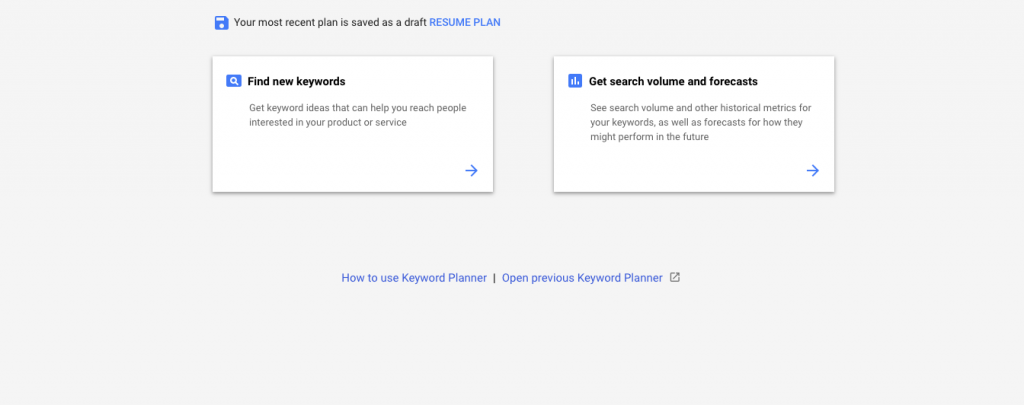
After you click, “find new keywords” we will enter one keyword that we want other relevant ones for. In our case, we are using “drywall company” as a keyword.

When we hit enter we will be taken to a page where we can see all the relevant keywords, the search volume, cost per click (although normally I find it is significantly cheaper than what they say), and other useful information.

Here we will start collecting keywords. I normally put them in a spreadsheet so we can manage the keywords for each company easily and across our team, but you can copy and paste them into the ad set.
Here you will get a good idea of what other people are searching for. You need to be intuitive about your customer to understand what someone might search and if that customer who searches a keyword is your ideal client. For example, someone who searches for a contractor vs a company might be looking to work individually with someone. Depending on your company this person might not be a good fit.
Now we need to go back and insert them into our campaign. However, before we do we need to talk about the different ways we can target these keywords.
Google used to only target keywords broadly, but they are always changing the platform. The recently added in broad match modifiers.

PAY ATTENTION: THIS IS WHERE PEOPLE LOSE MONEY
There are four main categories, broad match, exact match, phrase match, and broad match modifiers.
Most people fall into the mistake of putting all the keywords as broad match. You do this by just putting in the word without quotations, pluses, or brackets. If your keyword is shoe you will show up anytime the word shoe shows up in a search regardless of the other words around it.
For all small and medium-size businesses, you do not want to be doing broad match at all. Generally, people only use broad match for brand names and brand awareness. We want to be much more targeted.
Great campaigns are made up of exact matches, phrase matches, and broad match modifiers.
For exact matches, you will put the word in brackets. So for example [dry waller] would mean that your ad would only show up when someone types in the keyword exactly as shown. Normally this is too strict because most people will not type only this keyword.
So we also want to use phrase match, “dry waller” and broad match modifiers +dry+waller. In phrase matches, you will also show for people who are looking for “dry waller near me”, “dry waller (insert city)”, “best drywallers”, etc. While for broad match modifiers you will appear for “drywallers”, “drywalers” “dry wallers nearme” and any close spelling of your keyword.
We generally recommend that for each keyword you put in the exact, phrase, and modified version of the keyword.

Now you will need to add in as many keywords as needed for each ad set and create as many ad sets (services) as needed.
After you are done creating your ad sets we will move on and make ads for each ad set.
Step #8: Crafting High Quality Google Ads
Now it’s time to start creating your ad. Here you are required to create two headlines, and the total amount of symbols in each of them should not exceed 30.
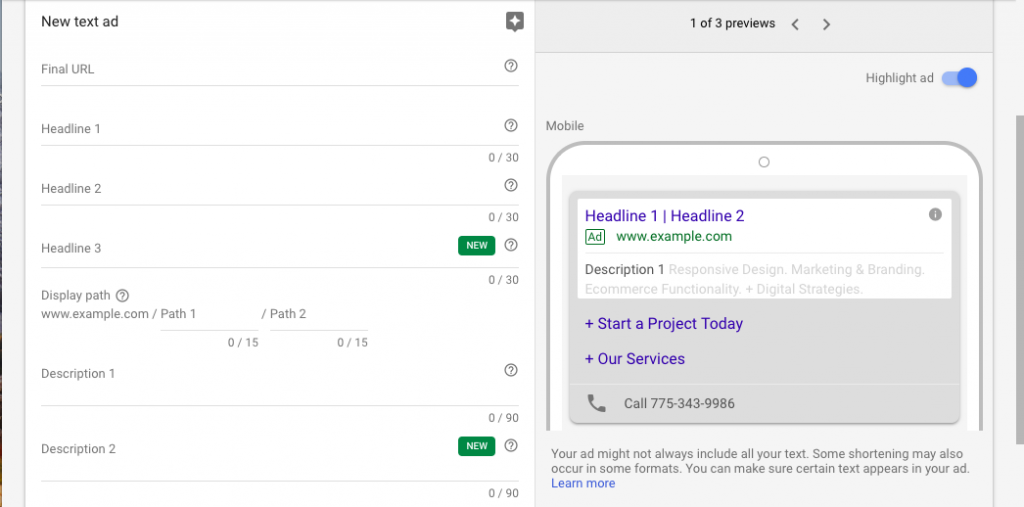
You should think carefully when creating headlines for your Google Ads campaign.
Wrong headlines might be the reason why your Google Ads results suck. Google recommends using some of the keywords when creating headlines for your campaign.
When you’ve come up with the headlines, it’s time to create a short description, which should not contain more than 80 symbols. It is also recommended to use keywords in your description as well as point out benefits.
We are going to look at examples of good ad copy.

The main headline gives the name of the doctor as well as a keyword in the title “back pain relief”. They point out that they have flexible hours and they also have a call to action at the end.
They could supercharge their ad with better ad copy, but in comparison to the first one, it has a better copy.
You want to be specific in your ad copy. You only have a few seconds to grab your potential customers attention.
Step #9: Optimizing Google Ad Campagin
For the most part, your campaign is set up. Now you will need to enter your billing information and publish your first campaign. Congrats!
However, it does not end there! Now that you have the campaign running you need to get data and start optimizing it for peak performance.
To optimize you need to start gathering data so you can start refining. You will first want to start taking out keywords that you do not want to show up for. You can add these keywords to your negative keywords list.
Then the next import part is to increase budgets on the ad sets or keywords that are outperforming and cut the ones that are underperforming. We generally find that a majority of the conversions will come from a handful of the keywords. The problem is we do not know which ones will convert. So as your campaign runs for longer periods of time then you will be able to squeeze more and more out of your budget getting more customers at a lower cost per click.
Here is how you can optimize your ad for responsiveness:
1. Upgrade to expanded text ads
Mobile ads with expanded text provide more space and perform better on mobile devices. If you want to take advantage of expanded text ads, you should update your existing text ads. It is free to do so.

How to convert your existing ads into expanded text ads
- Log in to your Google Ads account.
- Click Ads & extensions from the page menu on the left.
- Click the pencil icon next to the text ad you wish to edit. Your existing ad’s text is used to populate fields in the new format, so you already have an advantage in creating the newly expanded ad.
- Provide a final URL, headline text, description text, and optional path text. As you type, a mobile and desktop version of your advertisement will appear immediately in the “Ad preview.”
- Click Save Ad when you are satisfied with your new text ad.
2. Make sure you use the correct ad extensions for mobile
In addition to your ad, you can include additional information about your business, such as an address, phone number, or a link to a specific page on your website. These extensions help make your mobile ads more prominent and inviting to customers.
Ad extensions are free of charge, but you are charged for clicks on your ads as usual.
Here are a few ad extensions that can assist you in improving ad performance on mobile:
Add sitelink extensions to drive online sales
Extensions for Sitelinks allow you to link to specific pages of your website, such as your store hours or a featured product. This allows visitors to skip straight to what they are looking for directly from your ad.
Add location extensions to drive store visits
Local extensions display information about your business such as a map, your address, or the distance from your business. By using this method, people get an immediate sense of the location of your business, so they can easily find and visit you.
Add call extensions to drive phone calls
Call extensions add a phone number to your ad, which can increase clickthrough rates by 4-5%. This allows people to call your business directly and connect to you right away.
You need to monitor your results carefully and make sure that everything stacks up against your overall Digital Marketing Strategy. Use of measurements tools like Google Analytics is an absolute necessity (you will anyway be linking your campaigns to Analytics) but to get a better feel use a tool like the Canadian dashthis which will give you a much better overall view of Google Ads against other channels.
3. Best practices for writing effective mobile ads
- Attract attention with compelling headlines. This is the first thing people see. As the most prominent and clickable part of your mobile advertisement, make it relevant and appealing. If you include your keywords, people will know right away that your ad is relevant to what they are looking for.
- Include a strong call to action. A strong, clear call-to-action lets mobile visitors know what to expect and encourages them to act in a desired manner. Use strong verbs such as Buy, Call Today, Order, Sign Up, or Request a Quote. You will avoid having to pay for clicks that are unlikely to result in business if you select the appropriate action phrase.
- Use your description text to its full potential. Emphasize what makes your company unique and what your customers are looking for. Highlight your unique selling propositions. There are a number of characteristics (service, reliability, product selection, particular prices or promotions, etc.) that distinguish you from your competitors.
- Rotate multiple variations of an advertisement. Google Ads will show the best-performing ad by default if you have more than one ad in an ad group. A good strategy is to have two to four different ads, each with a different headline or description.
- Invest in keywords that are likely to yield results. You can reach the customers you desire by using high-quality and relevant keywords in your advertising campaign.
- Remove irrelevant terms. It is possible to filter out specific terms that people might search for that are not related to your business. When you add a negative keyword, it prevents your ad from being triggered when someone searches with that word or phrase.
- When you’re new to online advertising, we recommend that you let AdWords manage your bids automatically to help you get the most clicks possible within your budget. Once you’ve set up conversion tracking, you can use automated bidding to make bids based on converted users.
4. Calculate your return on investment (ROI)
In order to calculate the value of your Google Ads campaign, you must set up conversion tracking.
A conversion occurs when a customer clicks on your ad and completes an action that you find valuable, such as purchasing your product, filling out a contact form, or making a phone call. The conversion tracking process records these events.
Conversion tracking gives you insights into whether your Google ads are making or losing money. By doing so, managers, marketers, and other decision-makers can change or replace ads that work for their brand. Many marketers employ various strategies to calculate conversion ROI.
Get the following two numbers from Google Ads for the past 30 days:
- The number of conversions you have received. The number of conversions can be found in the conversions column in your reporting table.
- How much money you spent on Google Ads. This is the amount you allocated to Google Ads each month.
Gather (or estimate) the following two numbers from your business:
- The average revenue generated by conversions. The average revenue generated per sale (or per new customer). To determine precisely how much you earned, you can set a value on each conversion.
- Costs associated with your operations. This does not include advertising expenses.
Calculate your revenue:
Your revenue is your conversions multiplied by your average revenue per conversion. For instance, 25 conversions x $40 per conversion = a total revenue of $1000.
Calculate your costs:
Google Adwords costs (budget) plus your business overhead are your costs. For example, $400 budget + $500 overhead = $900 in total.
You can calculate your return on investment by doing the following:
Due to conversions and brand exposure that can’t always be tracked, the value of your Google Ads campaign is probably higher than what you calculate here. Subtract your costs from your revenue to estimate your minimum return on investment. $1000 total revenue minus $900 total cost equals $100 total profit.
Want to know more? Here is our guide on Google Ads ROI calculator.
Step #10: Optimize a landing page for Adwords
The objective of designing a landing page is to concentrate the message that has been previously given to the user so that he is clear that what he has found is what he was looking for and also to direct it towards conversion. A Google Ads Audit is always a good idea as well.
Your mobile landing page plays a significant role in converting clicks into customers. When someone clicks on your advertisement, they expect to be directed to a page that is relevant to what they saw in your advertisement. In the event that they do not find what they are looking for, they are more likely to leave your site.
Designing and optimizing a landing page is essential to reduce the bounce rates of a website and to increase conversion rates, but if the user’s visit has also been paid, as with Adwords, the optimization of the landing page becomes capital.
If you have not yet made your website mobile-friendly, it is a good idea to do so. Here are a few reasons why your mobile presence is essential:
- Sites that are mobile-friendly appear higher in search results
- . Searches made on Google.com using mobile devices account for more than half of the total searches.
- Mobile devices provide the majority of traffic for many advertisers.
- Visitors are five times more likely to abandon a website that is not mobile-friendly
Try opening your website on your smartphone as if you were a potential customer. Does it load quickly? Can you easily locate the information you are looking for?
In order to design a mobile-friendly website, you should prioritize easy navigation that connects users with the content they are seeking.
You may have a mobile website that loads quickly and is easy to use, but whether it is effective depends on whether it inspires people to do business with you.
It is essential to focus on design improvements that encourage visitors to take the action you wish to take, depending on your marketing objective. Here are some suggestions tailored to particular marketing objectives:
- Reduce the complexity of your forms. You should ensure that a potential customer can access your forms quickly and that data entry is limited and manageable.
- Limit the amount of scrolling and zooming. You should only use the space available on a mobile device. When people scroll and zoom, it is difficult to avoid making mistakes when entering their information.
- Make sure you select your data fields carefully. Please ensure that the information you request on your form can be easily accessed and validated. Use validation to indicate if any fields are incomplete.
- Assist people in making their purchases. Place any directions or “Buy Now” buttons prominently on your site. Utilize existing account information if possible to limit your customers’ data entry.
- Allow people to resume from their desktops. For example, you should make it easy for people to return to their shopping cart from their desktop computer to complete their purchases.
The connection between your mobile ad and landing page is the bridge between a potential customer and the action you want them to take.
The stronger the connection between your ad and landing page, the better your chances of getting results.
Further reading:
Google Ads Smart Campaigns: What Are They And Should You Use Them?
Comparing Facebook & Google Ads Auction
What are the advantages of optimizing a landing page for Adwords?
Well, the biggest advantage for optimizing our Landing Page is basically economical. Costs and conversions:
– We will improve the relevance of the LandingPage in relation to the ads and keywords and therefore we will also improve the Quality Score
– Our ads will be better considered by Google and will show them better positioned
– We will reduce the bounce rate
– We will increase the conversion rates
We highly recommend using a good tool to build your landing page correctly.
Do you think this is enough reason to optimize your landing page? Well let’s go with it:
1. SEO optimization of a landing comes in handy to improve the Quality Score of your Adwords campaign
- Use keywords in the landing title with a clear and optimized text
- Include keywords in the landing page URL, based on campaign keywords
- Keep track of the H1 tag, as always includes keywords but with common sense and a consistent text
- Write the landing texts using bold and italics to highlight the keywords that you want to give more relevance to.
- Tag the landing page images with your keywords
- Your landing page should try to guide the user towards conversion on the website, so always write for people, not for Google.
- Use common sense in the writing of texts and try to achieve the perfect balance between the use of keywords and natural texts. Common sense is the best tool you can find.
2. Loading speed
More than anything else, loading speed involves customer experience. Google has been very open and vocal about enhancing customer experience rather than focusing on the technical side of things. Therefore, marketers, web designers, and site developers must remember this important reminder.
The loading speed of the landing page is a factor increasingly taken into account by Google, although it is not a decisive factor. Try to design and configure a quick landing.
Use tools such as Google Chrome’s Page Speed or Pingdom.com (http://tools.pingdom.com/fpt/) to find out this landing information
3. Make it traceable and accessible
Many times a landing page is designed for the exclusive use of Adwords campaigns and they are blocked from the robots.txt file so that they are not indexed, and also they are not linked in the web so that a user is not able to arrive at that landing if they do not arrive from the Adwords. This is also taken into account by Google and is frowned upon.
Design and raise the landing page so that you can integrate it into the web for the user and do not prevent Google from being able to index it.
Do you want to make your landing pages stand out from the rest? Make it more accessible and traceable for Google and online users. You can work with an experienced and qualified web designer and developer to accomplish this goal for a more comprehensive and user-friendly design of your landing pages.
Conclusion
Crafting a Google Ads campaign is as much an art as it is a science. You have to use the data you are given to speak to real consumers. You have to out-compete your competition and stand out. If you need help with your campaign or would like us to do a free audit of a current one please send us a message and we can schedule a time to talk.
What Is WooCommerce Product Slider and Why Your Store Needs It
Why Do Product Images Matter So Much in Online Stores? When someone visits an online store the…
0 Comments9 Minutes
How to Streamline Your Customers’ Shopping Experience?
The goal for any online store is to make shopping as smooth as possible. When visitors move…
0 Comments8 Minutes
Strengthening Brand-Customer Relationships Through Gamified Loyalty Programs
Creating lasting connections with customers has become increasingly vital as the marketplace grows…
0 Comments6 Minutes
How to Use SEO and SEA Together in Search Engine Marketing
In digital marketing, search engine marketing (SEM) plays a critical role in improving online…
0 Comments10 Minutes
Content Marketing Growth Hacks: Real Shortcuts to Drive Traffic
Are you still lagging in content marketing? Sticking to these old strategies seems…
0 Comments10 Minutes
How to Build a Strong Local Following Using Social Media Marketing
In the days of likes, shares, and stories, local businesses have a golden opportunity to create…
0 Comments9 Minutes
Why WooCommerce is the Best Choice for Your Online Store?
WooCommerce stands out as a top option for anyone looking to build an online store. This platform…
0 Comments8 Minutes
How to Use AI-Powered SEO Tools for WordPress eCommerce
SEO is a critical factor in the success of any e-commerce WordPress store. As competition…
0 Comments11 Minutes
31 Comments
Comments are closed.
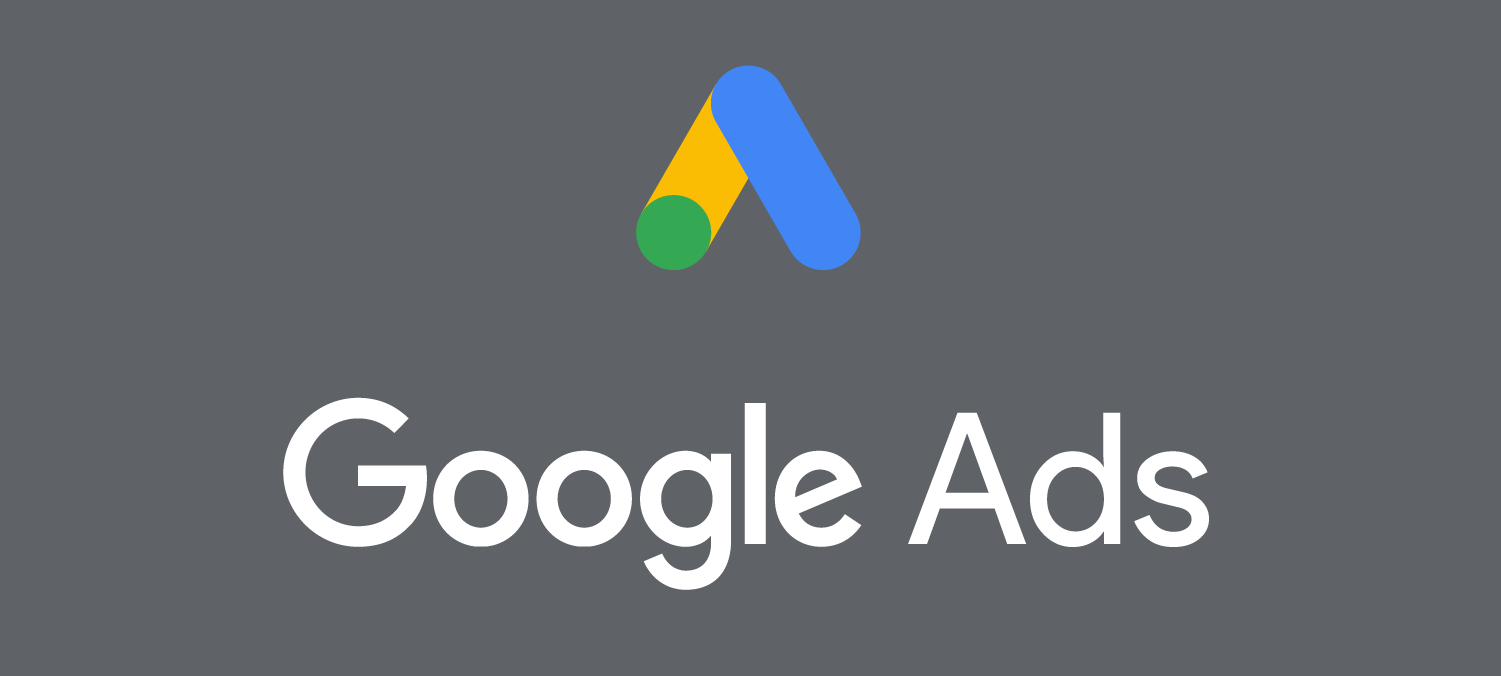








Your article is very interesting, thank you very much. It could complement the one written by our expert in our digital marketing agency. They give you 10 Performance Marketing Tricks to Improve Your Google Ads. I give you the link; https://www.codedesign.org/10-performance-marketing-tricks-improve-google-ads/ and therefore invite you to tell me what you think. Thank you, have a good day.
Thanks for sharing this article. Quite helpful to me.
Google ads can provide the positive impact on how much revenue and profit your good organic rankings produce. If you good presence then you are bound to gain aggregate value for your organic listings because, if you are marketing well, your traffic will go up, click-through rate will go up and your conversion rate will go up as well.
Hey guys, for those of you who have a very minimal budget for CPC and CPM, you can try www.igniterads.com. They accept as low as $50 and a minimum of $0.01/click. I’ve tested their platform and all clicks are 99% truly organic.
I found it interesting that you said that creating the wrong headlines for your google ads can give you problems in your google search results. My best friend told me that he was going to start advertising his products online. I’m going to share with him this information so that he can consider hiring a professional help him.
it’s a very helpful post can you help me with google shopping ads
Simple yet elaborate step by step on Google Ads which is most useful for beginners. I hope it reaches many people. Thanks for writing and sharing it.
Great guide to the basics. Would be good to see more about conversion tracking and automation though. I’ll keep an eye out.
Nice post Curtains Dubai
Awesome Post!!! Thanks for the article.
Excellent overall post on google ads. Will be more useful to business owners and marketing beginners. Thanks for writing and sharing this post.
Great tips, as I was searching for quality articles to enhance my skills as a marketer. I believe this will really help. Thank you mate
Excellent blog! Thanks for sharing the step by step guide. Now it’s 2020 but still, the blog information is really good and excellent. Please keep sharing.
such useful information thanks for sharing with us visit our site.
this really nice blog
Thanks for this listicle blog, every step to create camapaign is explained clearly with images. By going through this blog a novice is also able to create campaign.
Your article is very Informative for all. every step to create campaign is explained clearly with images. Thanks for sharing this great article with us.
I found it interesting that you said that creating the wrong headlines for your google ads can give you problems in your google search results. My best friend told me that he was going to start advertising his products online. I’m going to share with him this information so that he can consider hiring a professional help him.
Thanks for sharing with us.
Great post keep posting thank you!!
very nice information thanks for sharing this useful post
these steps will helps every google ads beginner to start with PPC in google.
Great article! Thank you for the detail. This process is quite complex and your article helped provide more clarity. There’s still a lot to digest. I work at a university and we are considering using google ads to recruit young adults (18-35) for one of our free weight loss research studies. We are still not sure if it’s the best route for us, given our budget and target participant demographic. Any advice?
Maybe Social Media may be better for your demographic. Think Instagram or TikTok.
Hi, thanks for sharing such useful information. Keep posting 🙂
i am impressed your blog.thanks for sharing with us
I am so impacted very good blog
these steps will helps every google ads beginner to start with PPC in google.Thank you and good luck with the upcoming Blog.
Great post keep posting thank you!!
i am impressed your blog.thanks for sharing with us
i am impressed your blog.